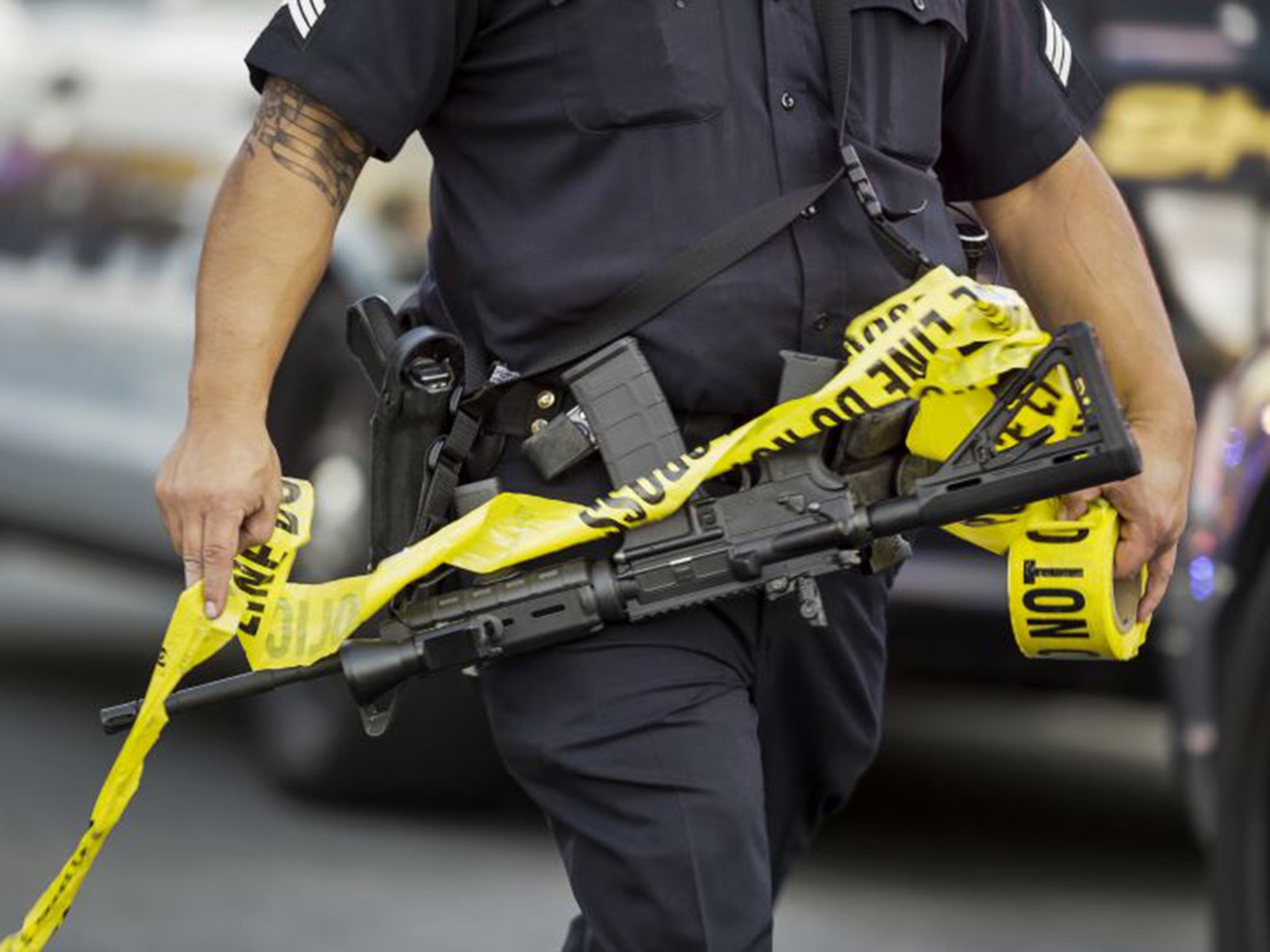San Bernardino shootings: Mass shootings involving multiple attackers are extremely rare
Shootings requires more plotting when multiple individuals are involved, which heightens the chance of being intercepted by law enforcement

If the number of suspects in Wednesday’s mass shooting in San Bernardino remains unchanged, it would make the massacre highly unusual among “active shooter” incidents, according to recently released statistics.
Authorities in the Southern California city believe at least two — and maybe three — people opened fire at a centre for people with developmental disabilities, killing 14 people and wounding 17 others at a social services center.
The investigation at the sprawling Inland Regional Center has just begun and information regarding the mass shooting remains fluid. In the initial hours after many active-shooting incidents, there are often reports of multiple gunmen as authorities rush to respond to chaotic and confusing scenes.
But hours after authorities first responded to reports of gunfire, authorities said two suspects — a man and a woman — were dead following a shootout with police. A third person was in custody — though, San Bernardino Police Chief Jarrod Burguan said, “we don’t know if that person was involved.”
An FBI report released in September 2014 said there were 160 active shooter incidents in the United States between 2000 and 2013. Among those, all but two involved a single shooter, the report states.
The two exceptions, according to the FBI:
• On April 6, 2012, Jacob Carl England, 19, and Alvin Lee Watts, 32, each armed with a handgun, drove through the streets of Tulsa, Oklahoma firing their weapons, killing three people and wounding two others, according to the report.
• On August 27, 2011, Tyrone Miller, 22, and an additional unidentified shooter(s), armed with handguns, allegedly began shooting at a house party in the Queens, New York, according to the report. Miller was arrested two years later in North Carolina, but the unidentified suspect(s) remains at large.
The FBI’s definition excludes the D.C.-area sniper shootings, which began on 2 October, 2002, when John Allen Muhammad and Lee Boyd Malvo began shooting Washington-area residents — a string of attacks that left 10 dead and three seriously wounded.
According to the FBI report: “Active shooter is a term used by law enforcement to describe a situation in which a shooting is in progress and an aspect of the crime may affect the protocols used in responding to and reacting at the scene of the incident. Unlike a defined crime, such as a murder or mass killing, the active aspect inherently implies that both law enforcement personnel and citizens have the potential to affect the outcome of the event based upon their responses.”
The agency’s report did not include active-shooter incidents from 1999, the year two students at Columbine High School in Littleton, Coloroad, killed 12 students and a teacher before turning their guns on themselves.
Police said one of the shooters involved in Wednesday’s massacre was a woman, which makes the incident even more unusual: Among the 160 active-shooter incidents logged by the FBI, only six of the shooters were female, the report states.
Attacks involving multiple shooters are significantly less common because they require a shared ideology, according to Jeffrey Simon, a visiting lecturer in the UCLA Department of Political Science and the author of “Lone Wolf Terrorism: Understanding the Growing Threat.”
It requires more plotting when multiple individuals are involved, which heightens the chance of being intercepted by law enforcement, Simon said Wednesday.
“Even on this small scale, when multiple individuals are involved, they have to do targeting, some surveillance, they have to know where and when they’re going to attack,” Simon said. “Unless today’s shooting was a spontaneous operation, there was some commonality between the … individuals.”
He added: “The puzzling issue is why they chose the centre as the place of attack. One of the suspects might have a work relationship there or are targeting an individual. There could have been many more casualties in a shopping mall or another soft target, but they chose this one.”

It’s much more common, Simon said, for a single person to turn to violence because of an emotional issue or personal grievance.
David Hemenway, professor of Health Policy at Harvard, said that many active-shooter incidents are driven by suicidal individuals who want “to go out in a blaze of glory.”
Wednesday’s incident, Heneyman said, “seems very unusual.”
“If you have a buddy, you’re probably less inclined to commit suicide and destroy your life, unless you have a cause,” he said. “Columbine was pretty unusual. That was like Leopold and Loeb. Most of the time people who do this are just loners.”
“This one seems very different, like an act of terrorism or something,” he added.
Of the 28 deadliest shootings in U.S. history before Wednesday — from Howard Unruh’s 1949 rampage in Camden, New Jersey, to Christopher Sean Harper-Mercer’s killing spree at Umpqua Community College in Roseburg, Oregon, in October — only two have come at the hands of multiple shooters: the February 1983 killings at the Wah Mee gambling and social club in Seattle and the Columbine High School massacre in Littleton, Colorado, in 1999.
Wednesday’s mass shooting was the deadliest in the United States since 2012, when a lone gunman killed 20 children and six adults at Sandy Hook Elementary School in Newton, Conn.
Join our commenting forum
Join thought-provoking conversations, follow other Independent readers and see their replies
Comments
Bookmark popover
Removed from bookmarks